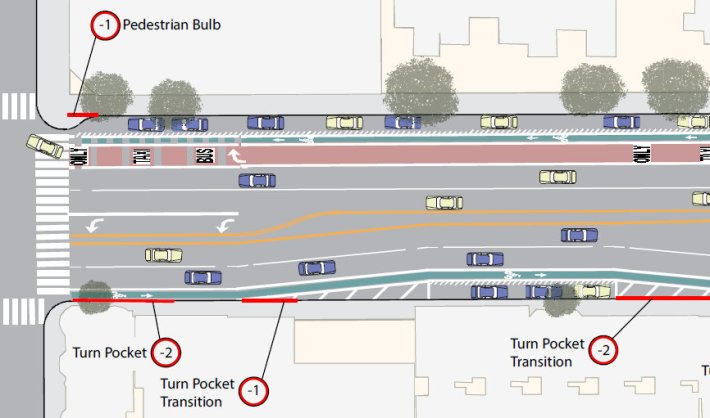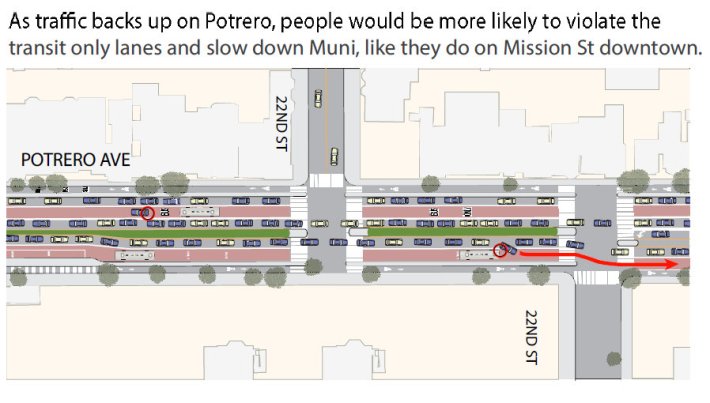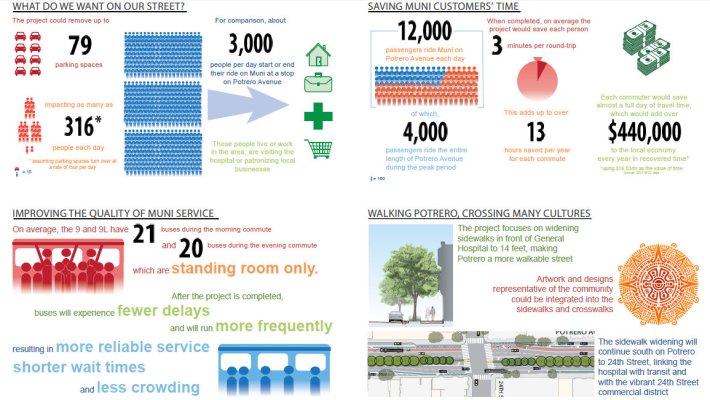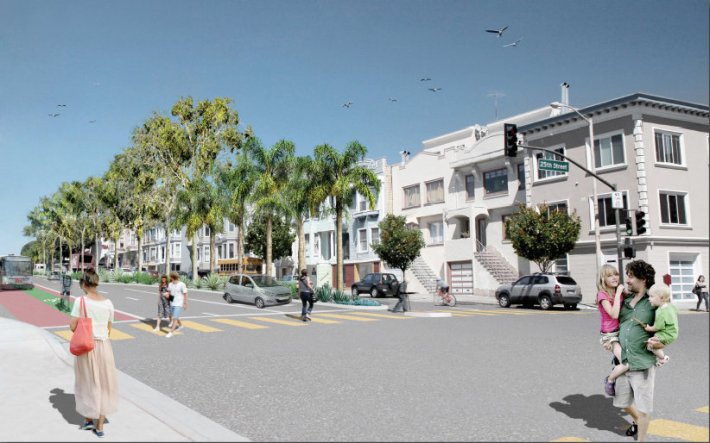
The latest proposals for a redesign of Potrero Avenue include no protected bike lanes and only one transit lane, while the removal of any of the street's four lanes devoted primarily to private car traffic remains off the table.
Planners from the SFMTA and the Department of Public Works presented two design options at an open house community meeting last night, one of which [PDF] would actually eliminate the existing southbound bike lane and instead place colored bike markings in the transit lane, denoting that riders are expected share it with buses. The northbound side of Potrero would have a buffered bike lane. The other option [PDF] would basically maintain the striped, unprotected bike lanes on each side.
Under both options, the eastern sidewalk would be widened to 14 feet along the four blocks in front of SF General Hospital, and bulb-outs and a planted center median with pedestrian refuges would be added. Up to 79 car parking spaces would be removed, down from the previous estimate of 100, as planners have added more perpendicular an angled spaces on side streets.
Elliot Schwartz, a neighbor and livable streets advocate who bikes with his son in a rear seat, said he was disappointed with the options. "It moves the needle a little bit, but not much," he said. "It makes things better for people walking, it doesn't really do a thing for people biking as far as safety or comfort. It moves a bus lane from one side to the other -- they say that'll be more efficient, but why not add bus lanes in both directions?"
After the previous community planning meeting in late July, reader Josh Handel submitted a concept for Potrero that includes two transit lanes and protected bike lanes safe enough for a broad range of San Franciscans to feel comfortable using. The street is wide enough if one lane for car traffic was removed in each direction. But city planners claim that would result in unacceptable car congestion.
The Potrero project has faced resistance from some neighbors and merchants over the removal of car parking and traffic lanes. Flyers were reportedly handed out and placed on car windshields near SF General prior to the meeting, protesting the repurposing of parking spaces, mainly for bulb-outs and left-turn pockets.
Fran Taylor, a neighborhood livable streets advocate, said she was upset by "the callous indifference to users of San Francisco General Hospital shown in a petition that demands that plans for sidewalk widening be squelched to save storage space for cars."
The plan "seems like a poor compromise between people who come to these meetings and argue that they don't want to give up their free parking space that they've had for years," said Schwartz, "and people who'd actually like to see safer streets so they can ride a bike with their kids and things like that."
Schwartz said the bike/bus lane "seems crazy," and though he'd be willing to try it, it probably wouldn't feel safe enough for most residents.
"It's a step in the right direction, but we continue to hear calls for the strongest possible improvements to make Potero safe for walking and biking," said Kit Hodge, deputy director of the SF Bicycle Coalition.

According to the meeting presentations [PDF], city planners predict that under a scenario with only two traffic lanes for autos, drivers would violate red-colored transit lanes to bypass congestion. So, apparently, the street should be designed around transit lane violators. Even though colored transit lanes installed on Church Street and in other cities have yielded promising results so far -- and police enforcement certainly helps -- planners likened colored transit lanes on Potrero to the regularly-violated part-time transit lanes on downtown Mission Street, which are notoriously poorly marked with only dashed lane lines (on some stretches) and worn-down "Bus Only" stencils.
Planners also say that limited-stop Muni buses on the 9-San Bruno would be unable to merge into the congested lanes to pass local buses. So, they argue, a second transit lane would not speed up Muni buses substantially.
I overheard one city staffer describe such a proposal to an attendee as "very anti-car," saying that it "just wouldn't work."
"Transit users need to speak up for a dedicated bus lane and insist on enforcement so it doesn't just become a fifth car traffic lane," said Taylor.
The presentation boards did lay out some numbers comparing the predicted time savings for Muni riders to how many car owners would be affected by the removal of parking spots. No similar comparisons were shown for the removal of car traffic lanes and the potential benefits of increasing bicycle use and safety on the street.
As Schwartz pointed out, much of the car traffic on Potrero seems to be spill-over from the adjacent 101 freeway, since the street is currently designed to be a convenient bypass route. Some of that traffic, research shows, will dissipate if space for cars is re-allocated to more efficient modes.
"The reason it seems that drivers have the most to lose is because they have the most to begin with," said Taylor. "We've designed our cities to accommodate cars over people, and considering humans first will take some adjustment."
"If you look at the Potrero-101 corridor, you have six lanes that are dedicated to private autos -- two travel lanes in each direction, and two parking lanes," said Schwartz. "You have another eight lanes on 101 that are only used for cars."
Schwartz noted that "you're really only giving 25 percent of the space over to people who walk, bike, and take transit," despite SF's transit-first policy, which mandates the prioritization of street space for non-automobile travel. "Twenty-five percent is not prioritizing."








